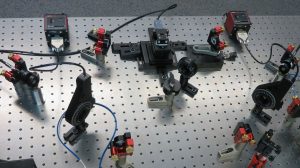Photonics and Quantum Optics Research Unit of Center of Excellence for Advanced Materials and Sensors at the Ruđer Bošković Institute announces realization and measurement of quantum entanglement of photon pairs. The experimental setup is schematically shown in the figure. A 405 nm wavelength purple laser beam is fed into Sagnac interferometer containing a periodically-poled crystal of potassium titanil-phosphate (PPKTP), schematically shown below on the left. The actual setup is shown on the right. Thanks to the nonlinear optical nature of the crystal and the specifically selected orientation of its lattice axes, some of the purple photons undergo a process of spontaneous parametric downconversion and thus split into a pair of infrared photons that are quantum entangled in polarization. Quantum entanglement of photons was evaluated in two ways.
First, we measured correlation of polarization of paired photons. To that end, each photon is sent to one of the polarization-measuring stations, named Alice and Bob. The actual setup is shown below. Alice and Bob are each realized as a polarizer mounted on computer-controlled, motorized mount, followed by an optical-fiber-coupled photon detector, as shown in the photo of the actual setup.
Alice can measure polarization along one of 4 special orientations (horizontal (H), vertical (V), diagonal (D) and anti-diagonal (A)). For each of the Alice’s orientations, Bob rotates his polarization analyzer for a full circle and they evaluate probability of measuring a photon polarization along their respective orientation, as a function of Bob’s analyzer angle. The probability forms a sinusoidal fringe, as shown in the figure below. Visibility greater than 50% for all 4 fringes is not possible if photons in a pair have predetermined polarizations. On the other hand, if photons are entangled, then visibility of all 4 fringes can reach the theoretical maximum of 100%. With our source we have obtained: VH = (99,8 +/- 0,6) %, VV = (99,7 +/- 0,4) %, VD = (98,5 +/- 0,4) %, VA = (98,3 +/- 0,4) %, as shown in the figure, which indicates near-maximal entanglement of photons.
We also used the Bell’s theorem and performed measurement of Clauser, Horne, Shimony, Holt (CHSH) parameter S, to test the CHSH form of Bell’s inequality. Classical physics predicts S ≤ 2, while quantum physics allows 2 < S ≤ 2√2 ≈ 2.828. We have experimentally obtained the value of S = 2,803 +/- 0,007 which is more than 114 standard deviations greater than the maximum value of 2 allowed by classical physics, again indicating the near-maximal entanglement.
These results demonstrate the non-local behaviour of quantum-entangled photon pairs, which is that the measurement of polarization performed on one photon has an immediate impact on the result of measurement of polarization on the other photon.



